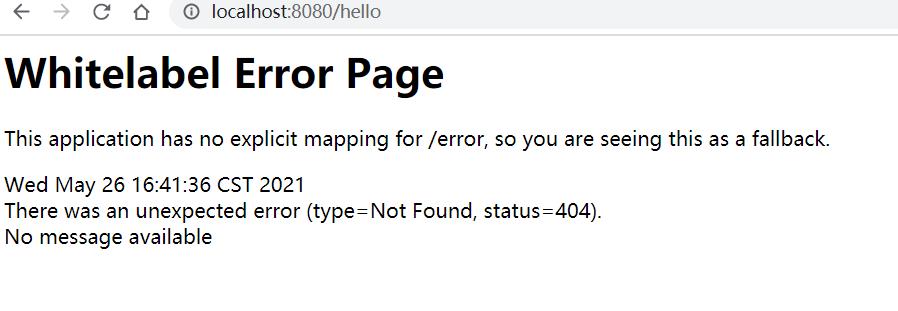12.springboot中常用的异常处理方式
Posted 结构化思维wz
tags:
篇首语:本文由小常识网(cha138.com)小编为大家整理,主要介绍了12.springboot中常用的异常处理方式相关的知识,希望对你有一定的参考价值。
springboot中常用的异常处理方式

springboot中既可以用spring中的@ControllerAdvice 进行统一处理,也可以采用springboot中的自定义异常处理方案,springboot中对异常处理有默认的方案,当然我们一般会自定义异常处理方案。
## 一般默认的错误页面:
因为开发者没有明确提供一个 /error 路径,如果开发者提供了 /error 路径 ,这个页面就不会展示出来,不过在 Spring Boot 中,提供 /error 路径实际上是下下策,Spring Boot 本身在处理异常时,也是当所有条件都不满足时,才会去找 /error 路径。那么我们就先来看看,在 Spring Boot 中,如何自定义 error 页面,整体上来说,可以分为两种,一种是静态页面,另一种是动态页面。
优先级:动态详细>静态详细>动态模糊>静态模糊
静态页面
-
默认路径
---static--- ---error--- ---404.html---- 只展示404错误 ----4xx.html---- 展示400-499错误,文件中如果有404等更明确的,会按照更明确地
动态页面
使用页面模板来做,更为灵活。
默认路径也需要在error下!
----templates-----
----error-----
----500.html---
<!DOCTYPE html>
<html lang="en">
<head>
<meta charset="UTF-8">
<title>Title</title>
</head>
<body>
<!DOCTYPE html>
<html lang="en" xmlns:th="http://www.thymeleaf.org">
<head>
<meta charset="UTF-8">
<title>动态异常处理</title>
</head>
<body>
<table border="1">
<tr>
<td>path</td>
<td th:text="${path}"></td>
</tr>
<tr>
<td>error</td>
<td th:text="${error}"></td>
</tr>
<tr>
<td>message</td>
<td th:text="${messages}"></td>
</tr>
<tr>
<td>timestamp</td>
<td th:text="${timestamp}"></td>
</tr>
<tr>
<td>status</td>
<td th:text="${status}"></td>
</tr>
</table>
</body>
</html>
</body>
</html>
![[外链图片转存失败,源站可能有防盗链机制,建议将图片保存下来直接上传(img-vRuado20-1622022281419)(D:\\OneDrive\\桌面\\springboot2\\springboot王泽\\动态异常页面.png)]](https://image.cha138.com/20210602/9f673e74671143ed9ef003985b1f6846.jpg)
自定义异常(数据)
-
在源码中我们可以看到 springboot 中关于异常的五条数据的定义:
@Override public Map<String, Object> getErrorAttributes(ServerRequest request, boolean includeStackTrace) { Map<String, Object> errorAttributes = new LinkedHashMap<>(); errorAttributes.put("timestamp", new Date()); errorAttributes.put("path", request.path()); Throwable error = getError(request); HttpStatus errorStatus = determineHttpStatus(error); errorAttributes.put("status", errorStatus.value()); errorAttributes.put("error", errorStatus.getReasonPhrase()); errorAttributes.put("message", determineMessage(error)); handleException(errorAttributes, determineException(error), includeStackTrace); return errorAttributes; }如果开发者没有自己提供一个 ErrorAttributes 的实例的话,那么 Spring Boot 将自动提供一个ErrorAttributes 的实例,也就是 DefaultErrorAttributes 。
-
开发者自定义 ErrorAttributes 有两种方式 :
- 直接实现 ErrorAttributes 接口
- 继承 DefaultErrorAttributes(推荐),因为 DefaultErrorAttributes 中对异常数据的处理已经完成,开发者可以直接使用。
-
实现方式:
@Component public class MyErrorAttributes extends DefaultErrorAttributes { @Override public Map<String, Object> getErrorAttributes(WebRequest webRequest, ErrorAttributeOptions options) { Map<String, Object> map = super.getErrorAttributes(webRequest, options); if((Integer) map.get("status") == 404){ map.put("message","没有此页面"); } return map; } }
自定义异常(视图)不常用,因为springboot提供的已经很够了
以上是关于12.springboot中常用的异常处理方式的主要内容,如果未能解决你的问题,请参考以下文章